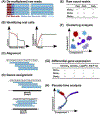Beyond bulk: a review of single cell transcriptomics methodologies and applications
- PMID: 30978643
- PMCID: PMC6710112
- DOI: 10.1016/j.copbio.2019.03.001
Beyond bulk: a review of single cell transcriptomics methodologies and applications
Abstract
Single-cell RNA sequencing (scRNA-seq) is a promising approach to study the transcriptomes of individual cells in the brain and the central nervous system (CNS). This technology acts as a bridge between neuroscience, computational biology, and systems biology, enabling an unbiased and novel understanding of the cellular composition of the brain and CNS. Gene expression at the single cell resolution is often noisy, sparse, and high-dimensional, creating challenges for computational analysis of such data. In this review, we overview fundamental sample preparation and data analysis processes of scRNA-seq and provide a comparative perspective for analyzing and visualizing these data.
Copyright © 2019 Elsevier Ltd. All rights reserved.
Conflict of interest statement
Conflict of interest statement
Nothing declared.
Figures




References
-
- Stegle O, Teichmann SA, and Marioni JC, Computational and analytical challenges in singlecell transcriptomics. Nature Reviews Genetics, 2015. 16: p. 133. - PubMed
-
- Cristinelli S and Ciuffi A, The use of single-cell RNA-Seq to understand virus–host interactions. Current Opinion in Virology, 2018. 29: p. 39–50. - PubMed
Publication types
MeSH terms
Grants and funding
LinkOut - more resources
Full Text Sources
Other Literature Sources

